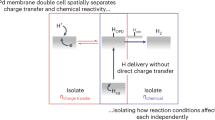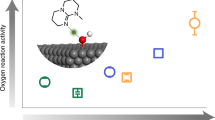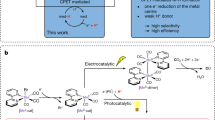Abstract
Hydride transfer is a critical elementary reaction step that spans biological catalysis, organic synthesis and energy conversion. Conventionally, hydride transfer reactions are performed using (bio)molecular hydride reagents under homogeneous conditions. Here we report a conceptually distinct heterogeneous hydride transfer reaction via the net electrocatalytic hydrogen reduction reaction (HRR), which reduces H2 to hydrides. The reaction proceeds by H2 dissociative adsorption on a metal electrode to form surface M−H species, which are then negatively polarized to drive hydride transfer to molecular hydride acceptors with up to 91% Faradaic efficiency. The hydride transfer reactivity of surface M−H species is highly tunable, and, depending on the electrode potential, the thermodynamic hydricity of Pt−H on the same Pt electrode can continuously span a range of >40 kcal mol−1. This work highlights the critical role of electrical polarization on heterogeneous hydride transfer reactivity and establishes a sustainable strategy for accessing reactive hydrides directly from H2.

This is a preview of subscription content, access via your institution
Access options
Access Nature and 54 other Nature Portfolio journals
Get Nature+, our best-value online-access subscription
$29.99 / 30 days
cancel any time
Subscribe to this journal
Receive 12 digital issues and online access to articles
$119.00 per year
only $9.92 per issue
Buy this article
- Purchase on Springer Link
- Instant access to full article PDF
Prices may be subject to local taxes which are calculated during checkout







Similar content being viewed by others
Data availability
The data that support the findings of this study are included in Supplementary Information of the published Article or are available from the corresponding author on reasonable request.
References
Belenky, P., Bogan, K. L. & Brenner, C. NAD+ metabolism in health and disease. Trends Biochem. Sci. 32, 12–19 (2007).
Hollmann, F., Arends, I. W. C. E. & Holtmann, D. Enzymatic reductions for the chemist. Green Chem. 13, 2285–2314 (2011).
Sellés Vidal, L., Kelly, C. L., Mordaka, P. M. & Heap, J. T. Review of NAD(P)H-dependent oxidoreductases: properties, engineering and application. Biochim. Biophys. Acta Proteins Proteom. 1866, 327–347 (2018).
Deno, N. C., Peterson, H. J. & Saines, G. S. The hydride-transfer reaction. Chem. Rev. 60, 7–14 (1960).
An, X.-D. & Xiao, J. Recent advances in hydride transfer-involved C(sp3)-H activation reactions. Org. Chem. Front. 8, 1364–1383 (2021).
Wang, F. & Stahl, S. S. Electrochemical oxidation of organic molecules at lower overpotential: accessing broader functional group compatibility with electron-proton transfer mediators. Acc. Chem. Res. 53, 561–574 (2020).
Waldie, K. M., Ostericher, A. L., Reineke, M. H., Sasayama, A. F. & Kubiak, C. P. Hydricity of transition-metal hydrides: thermodynamic considerations for CO2 reduction. ACS Catal. 8, 1313–1324 (2018).
Yang, J. Y., Kerr, T. A., Wang, X. S. & Barlow, J. M. Reducing CO2 to HCO2− at mild potentials: lessons from formate dehydrogenase. J. Am. Chem. Soc. 142, 19438–19445 (2020).
Kumar, A., Semwal, S. & Choudhury, J. Emerging implications of the concept of hydricity in energy-relevant catalytic processes. Chem. Eur. J. 27, 5842–5857 (2021).
Dey, S., Masero, F., Brack, E., Fontecave, M. & Mougel, V. Electrocatalytic metal hydride generation using CPET mediators. Nature 607, 499–506 (2022).
Ilic, S., Gesiorski, J. L., Weerasooriya, R. B. & Glusac, K. D. Biomimetic metal-free hydride donor catalysts for CO2 reduction. Acc. Chem. Res. 55, 844–856 (2022).
Wiedner, E. S. et al. Thermodynamic hydricity of transition metal hydrides. Chem. Rev. 116, 8655–8692 (2016).
Ilic, S., Alherz, A., Musgrave, C. B. & Glusac, K. D. Thermodynamic and kinetic hydricities of metal-free hydrides. Chem. Soc. Rev. 47, 2809–2836 (2018).
Mayr, H. & Patz, M. Scales of nucleophilicity and electrophilicity: a system for ordering polar organic and organometallic reactions. Angew. Chem. Int. Ed. 33, 938–957 (1994).
Hammes-Schiffer, S. Comparison of hydride, hydrogen atom and proton-coupled electron transfer reactions. ChemPhysChem 3, 33–42 (2002).
Yang, J.-D., Xue, J. & Cheng, J.-P. Understanding the role of thermodynamics in catalytic imine reductions. Chem. Soc. Rev. 48, 2913–2926 (2019).
Brereton, K. R., Smith, N. E., Hazari, N. & Miller, A. J. M. Thermodynamic and kinetic hydricity of transition metal hydrides. Chem. Soc. Rev. 49, 7929–7948 (2020).
Ferrin, P., Kandoi, S., Nilekar, A. U. & Mavrikakis, M. Hydrogen adsorption, absorption and diffusion on and in transition metal surfaces: a DFT study. Surf. Sci. 606, 679–689 (2012).
Skúlason, E. et al. Modeling the electrochemical hydrogen oxidation and evolution reactions on the basis of density functional theory calculations. J. Phys. Chem. C. 114, 18182–18197 (2010).
Nishimura, S. Handbook of Heterogeneous Catalytic Hydrogenation for Organic Synthesis (Wiley, 2001).
Gileadi, E. Physical Electrochemistry: Fundamentals, Techniques and Applications (Wiley, 2011).
Eisenstein, O. & Crabtree, R. H. Outer sphere hydrogenation catalysis. New J. Chem. 37, 21–27 (2013).
Jin, W. et al. Catalytic upgrading of biomass model compounds: novel approaches and lessons learnt from traditional hydrodeoxygenation—a review. ChemCatChem 11, 924–960 (2019).
Liu, K., Qin, R. & Zheng, N. Insights into the interfacial effects in heterogeneous metal nanocatalysts toward selective hydrogenation. J. Am. Chem. Soc. 143, 4483–4499 (2021).
Aireddy, D. R. & Ding, K. Heterolytic dissociation of H2 in heterogeneous catalysis. ACS Catal. 12, 4707–4723 (2022).
Nelson, R. C. et al. Experimental and theoretical insights into the hydrogen-efficient direct hydrodeoxygenation mechanism of phenol over Ru/TiO2. ACS Catal. 5, 6509–6523 (2015).
Wyvratt, B. M. et al. Reactivity of hydrogen on and in nanostructured molybdenum nitride: crotonaldehyde hydrogenation. ACS Catal. 6, 5797–5806 (2016).
Cai, H., Schimmenti, R., Nie, H., Mavrikakis, M. & Chin, Y.-H. C. Mechanistic role of the proton-hydride pair in heteroarene catalytic hydrogenation. ACS Catal. 9, 9418–9437 (2019).
Shangguan, J. et al. The role of protons and hydrides in the catalytic hydrogenolysis of guaiacol at the ruthenium nanoparticle-water interface. ACS Catal. 10, 12310–12332 (2020).
Bender, M. T., Lam, Y. C., Hammes-Schiffer, S. & Choi, K.-S. Unraveling two pathways for electrochemical alcohol and aldehyde oxidation on NiOOH. J. Am. Chem. Soc. 142, 21538–21547 (2020).
Barton, E. E., Rampulla, D. M. & Bocarsly, A. B. Selective solar-driven reduction of CO2 to methanol using a catalyzed p-GaP based photoelectrochemical cell. J. Am. Chem. Soc. 130, 6342–6344 (2008).
Zeitler, E. L. et al. Isotopic probe illuminates the role of the electrode surface in proton coupled hydride transfer electrochemical reduction of pyridinium on Pt(111). J. Electrochem. Soc. 162, H938–H944 (2015).
Xu, S. & Carter, E. A. Theoretical insights into heterogeneous (photo)electrochemical CO2 reduction. Chem. Rev. 119, 6631–6669 (2019).
Wu, H. et al. Methods for the regeneration of nicotinamide coenzymes. Green Chem. 15, 1773–1789 (2013).
Wang, X. et al. Cofactor NAD(P)H regeneration inspired by heterogeneous. Pathw. Chem. 2, 621–654 (2017).
Li, L., Martirez, J. M. P. & Carter, E. A. Identifying an alternative hydride transfer pathway for CO2 reduction on CdTe(111) and CuInS2(112) surfaces. Adv. Theory Simul. 5, 2100413 (2022).
Jung, O., Jackson, M. N., Bisbey, R. P., Kogan, N. E. & Surendranath, Y. Innocent buffers reveal the intrinsic pH- and coverage-dependent kinetics of the hydrogen evolution reaction on noble metals. Joule 6, 476–493 (2022).
Warburton, R. E., Soudackov, A. V. & Hammes-Schiffer, S. Theoretical modeling of electrochemical proton-coupled electron transfer. Chem. Rev. 122, 10599–10650 (2022).
Kunnen, K., Nikonov, G. & Yunnikova, L. 1,3-Dimethyl-2-phenylbenzimidazoline. in Encyclopedia of Reagents for Organic Synthethis 1–3 (Wiley, 2014).
Zhu, X.-Q., Zhang, M.-T., Yu, A., Wang, C.-H. & Cheng, J.-P. Hydride, hydrogen atom, proton and electron transfer driving forces of various five-membered heterocyclic organic hydrides and their reaction intermediates in acetonitrile. J. Am. Chem. Soc. 130, 2501–2516 (2008).
Purwanto Deshpande, R. M., Chaudhari, R. V. & Delmas, H. Solubility of hydrogen, carbon monoxide, and 1-octene in various solvents and solvent mixtures. J. Chem. Eng. Data 41, 1414–1417 (1996).
Dinh, C.-T., García de Arquer, F. P., Sinton, D. & Sargent, E. H. High rate, selective and stable electroreduction of CO2 to CO in basic and neutral media. ACS Energy Lett. 3, 2835–2840 (2018).
Naab, B. D. et al. Effective solution- and vacuum-processed n-doping by dimers of benzimidazoline radicals. Adv. Mater. 26, 4268–4272 (2014).
Tanner, D. D. & Chen, J. J. On the mechanism of the reduction of α-halo ketones by 1,3-dimethyl-2-phenylbenzimidazoline. Reduction by a SET (single electron transfer)-hydrogen atom abstraction chain mechanism. J. Org. Chem. 54, 3842–3846 (1989).
Barrett, S. M., Pitman, C. L., Walden, A. G. & Miller, A. J. M. Photoswitchable hydride transfer from iridium to 1-methylnicotinamide rationalized by thermochemical cycles. J. Am. Chem. Soc. 136, 14718–14721 (2014).
Christmann, K. Interaction of hydrogen with solid surfaces. Surf. Sci. Rep. 9, 1–163 (1988).
Sheng, W. et al. Correlating hydrogen oxidation and evolution activity on platinum at different pH with measured hydrogen binding energy. Nat. Commun. 6, 5848 (2015).
Noh, H. & Mayer, J. M. Medium-independent hydrogen atom binding isotherms of nickel oxide electrodes. Chem. 8, 3324–3345 (2022).
Tang, B. Y., Bisbey, R. P., Lodaya, K. M., Toh, W. L. & Surendranath, Y. Reaction environment impacts charge transfer but not chemical reaction steps in hydrogen evolution catalysis. Nat. Catal. https://doi.org/10.1038/s41929-023-00943-2 (2022).
Computational studies have predicted a range of ~80 kcal mol−1 for tetra-substituted borohydrides: Heiden, Z. M. & Lathem, A. P. Establishing the hydride donor abilities of main group hydrides. Organometallics 34, 1818–1827 (2015).
Ertem, M. Z., Konezny, S. J., Araujo, C. M. & Batista, V. S. Functional role of pyridinium during aqueous electrochemical reduction of CO2 on Pt(111). J. Phys. Chem. Lett. 4, 745–748 (2013).
Kil, H. J. & Lee, I.-S. H. Primary kinetic isotope effects on hydride transfer from heterocyclic compounds to NAD+ analogues. J. Phys. Chem. A 113, 10704–10709 (2009).
Shen, G.-B. et al. Prediction of kinetic isotope effects for various hydride transfer reactions using a new kinetic model. J. Phys. Chem. A 120, 1779–1799 (2016).
Jackson, M. N. & Surendranath, Y. Donor-dependent kinetics of interfacial proton-coupled electron transfer. J. Am. Chem. Soc. 138, 3228–3234 (2016).
Ledezma-Yanez, I. et al. Interfacial water reorganization as a pH-dependent descriptor of the hydrogen evolution rate on platinum electrodes. Nat. Energy 2, 17031 (2017).
Ledezma-Yanez, I. & Koper, M. T. M. Influence of water on the hydrogen evolution reaction on a gold electrode in acetonitrile solution. J. Electroanal. Chem. 793, 18–24 (2017).
Mikolajczyk, T., Luba, M., Pierozynski, B. & Smoczynski, L. A detrimental effect of acetonitrile on the kinetics of underpotentially deposited hydrogen and hydrogen evolution reaction, examined on Pt electrode in H2SO4 and NaOH solutions. Catalysts 10, 625 (2020).
Barrette, W. C. & Sawyer, D. T. Determination of dissolved hydrogen and effects of media and electrode materials on the electrochemical oxidation of molecular hydrogen. Anal. Chem. 56, 653–657 (1984).
Suárez-Herrera, M. F., Costa-Figueiredo, M. & Feliu, J. M. Voltammetry of basal plane platinum electrodes in acetonitrile electrolytes: effect of the presence of water. Langmuir 28, 5286–5294 (2012).
Mayer, J. M. Understanding hydrogen atom transfer: from bond strengths to Marcus theory. Acc. Chem. Res. 44, 36–46 (2011).
Ludwig, T., Singh, A. R. & Nørskov, J. K. Acetonitrile transition metal interfaces from first principles. J. Phys. Chem. Lett. 11, 9802–9811 (2020).
Zidan, R. et al. Aluminium hydride: a reversible material for hydrogen storage. Chem. Commun. 2009, 3717–3719 (2009).
Demirci, U. B. & Miele, P. Sodium borohydride versus ammonia borane, in hydrogen storage and direct fuel cell applications. Energy Environ. Sci. 2, 627–637 (2009).
Acknowledgements
We gratefully acknowledge A. Radosevich for fruitful discussions. We thank the entire Surendranath laboratory for their support and scientific discussions, with particular acknowledgements to D. Harraz, M. Hülsey and J. Ryu for reviewing the paper and H. W. Chung for proofreading and reproducing the data in Fig. 3. This work was supported primarily by the Air Force Office of Scientific Research (AFOSR) under award no. FA9550-18-1-0420. H.-X.W. acknowledges generous support from the Croucher Fellowship.
Author information
Authors and Affiliations
Contributions
H.-X.W. and Y.S. conceived the research and developed experiments. H.-X.W. conducted the majority of the experiments. W.L.T. and B.Y.T. contributed to experimental design and data analysis. H.-X.W. and Y.S. wrote the paper, with input from all authors.
Corresponding author
Ethics declarations
Competing interests
The authors declare no competing interests.
Peer review
Peer review information
Nature Catalysis thanks Victor Mougel and the other, anonymous, reviewers for their contribution to the peer review of this work.
Additional information
Publisher’s note Springer Nature remains neutral with regard to jurisdictional claims in published maps and institutional affiliations.
Supplementary information
Supplementary Information
Supplementary Methods, Figs. 1–25, Tables 1 and 2, note and references.
Rights and permissions
Springer Nature or its licensor (e.g. a society or other partner) holds exclusive rights to this article under a publishing agreement with the author(s) or other rightsholder(s); author self-archiving of the accepted manuscript version of this article is solely governed by the terms of such publishing agreement and applicable law.
About this article
Cite this article
Wang, HX., Toh, W.L., Tang, B.Y. et al. Metal surfaces catalyse polarization-dependent hydride transfer from H2. Nat Catal 6, 351–362 (2023). https://doi.org/10.1038/s41929-023-00944-1
Received:
Accepted:
Published:
Issue Date:
DOI: https://doi.org/10.1038/s41929-023-00944-1
This article is cited by
-
Hydride transfer gets a recharge
Nature Catalysis (2023)



